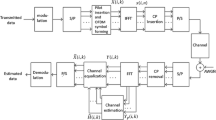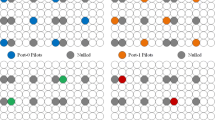Abstract
In this paper, we propose an adaptive guard interval (GI) for LTE-advanced using channel impulse response (CIR) length estimation. The CIR length is estimated from the channel autocorrelation function. This estimate can be used to generate linear minimum mean square error filter coefficients for data subcarriers channel estimation and to adjust the GI length adaptively. The simulation results show that the improvement of mean square error for signal to noise ratio of 30 dB with CIR length estimation is about 10 dB when compared to conventional methods. Also, due to adaptive GI, the relative spectral efficiency can be increased by 0.11 compared to the conventional system with constant GI.





Similar content being viewed by others
References
3GPP Technical Report 36.814. (2009). Further advancements of E-UTRA—physical layer aspects, version 0.4.0.
Saleem, S., Islam, Q., Aziz, W., & Basit, A. (2011). Performance evaluation of linear channel estimation algorithms for MIMO-OFDM in LTE-advanced. International Journal of Electrical and Computer Sciences, 11(03), 64–69.
Nguyen, V. D., & Kuchenbecker, H. P. (2002). Intercarrier and intersymbol interference analysis of OFDM systems on time-variant channels. In Proceedings of the IEEE interenational symposium on personal indoor and mobile radio communication, IEEE PIMRC 2002, Portugal.
Larson, E. G., Liu, G., Li, J., & Giannakis, G. B. (2001). Joint symbol timing and channel estimation for OFDM based WLANs. IEEE Communication Letters.
Chen, J. H., & Lee, Y. (2002). Joint synchronization, channel length estimation, and channel estimation for the maximum likelihood sequence estimator for high speed wireless communications. In Proceedings of the 56th IEEE vehicular technology conference.
Sheng, B., Wang, X., You, X., & Chen, L. (2009). Blind estimation of channel length for OFDM system. In 5th International conference on, wireless communications, networking and mobile computing, conference publication (pp. 1–3).
Zhang, Z., & Lao, L. (2004). A novel OFDM transmission scheme with length-adaptive cyclic prefix. Journal of Zhejiang University Science. 5(11), 1336–1342.
Hung, K.-C., & David, W. (2010). Pilot-based LMMSE channel estimation for OFDM systems with power delay profile approximation. IEEE Transaction on Vehicular Technology, 59(1), 150–159.
Kim, Y.-J., & Im, G. H. (2012). Pilot-symbol assisted power delay profile estimation for MIMO-OFDM systems. IEEE Communication Letters, 16(1), 68–71.
Gao, X., Wang, X., Zou, Y., & Ho, P. (2013). An efficient OFDM with adaptive guard interval for amplify and forward relay systems. In IEEE 78th vehicular technology conference (VTC Fall) (pp. 1–5), ISSN:1090-3038.
Gacanin, H. (2013). Joint iterative channel estimation and guard interval selection for adaptive powerline communication systems. In 17th IEEE international symposium on power line communications and its applications (ISPLC) (pp. 197–202) ISBN: 978-1-4673-6014-2.
3GPP. (2008). Technical specification group radio access network. In Evolved universal terrestrial radio access E-UTRA; physical channels and modulation TS36.211 (version 8.5.0), Technical Report.
Van de Beek, J. J., Edfors, O. S., Sandell, M., Wilson, S. K., & Borjeshon, O. P. (1995). On channel estimation in OFDM systems. In 45th IEEE vehicular technology conference, Chicago, II (Vol. 2, pp. 815–819).
Krondorf, M., Liang, T.-J., Irmer, R., & Fettweis, G. (2007). Algorithms and applications of channel impulse response length estimation for MIMO-OFDM. European Transactions on Telecommunications. 18, 583–594.
RECOMMENDATION ITU-R SM.1046-1. Definition of Spectrum Use and Efficiency of a Radio System (Question ITU-R 47/1).
Author information
Authors and Affiliations
Corresponding author
Rights and permissions
About this article
Cite this article
Kavitha, K., Manikandan, S. LMMSE Channel Estimation Algorithm Based on Channel Autocorrelation Minimization for LTE-Advanced with Adaptive Guard Interval. Wireless Pers Commun 81, 1233–1241 (2015). https://doi.org/10.1007/s11277-014-2181-5
Published:
Issue Date:
DOI: https://doi.org/10.1007/s11277-014-2181-5




